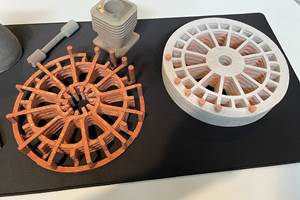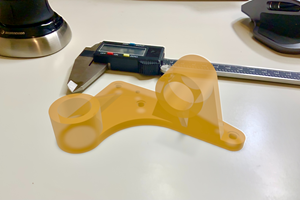Evonik’s PA12 Powder for 3D Printing Based on Biocircular Raw Material
Evonik’s Infinam eCO PA12 is a PA12 powder material for industrial 3D printing that substitutes 100% of fossil feedstock with biocircular raw material from waste cooking oil in a mass balancing process.
Share
Read Next
Evonik aims to drive the circular plastics economy in additive manufacturing (AM) with its Infinam eCO PA12 material which it says is the world’s first PA12 powder for 3D printing based on biocircular raw material. The specialty chemicals company is introducing this grade of its polyamide 12 powders which is designed to unbound sustainable 3D printing at scale.
Infinam eCO PA12 is a PA12 powder material for industrial 3D printing that substitutes 100% of fossil feedstock with biocircular raw material from waste cooking oil in a mass balancing process. The ready-to-use powder features a 74% reduction of CO2 emissions compared to the castor oil-based polyamides of Evonik's own Infinam Terra development grade.
Having already launched a new PA12 grade with reduced carbon footprint in late 2022, Evonik is now fully aligning its portfolio of polyamide 12 powders with its circularity approach.
The company says true circularity starts with biocircular raw materials. More than 15 million tons of waste cooking oils are produced annually in the world by restaurants, grocers, hotels and casinos, and other food service providers. In addition to other end-of-life possibilities like being processed into biodiesel, waste cooking oil can be used as raw material source for chemical production.
“True circularity is key for being successful in the future. As a pioneer for polymer-based 3D printing materials, Evonik has developed a formula for its PA12 powders to drive circular plastics economy in additive manufacturing,” says Dominic Störkle, head of the Additive Manufacturing Innovation Growth Field at Evonik. “With the introduction of Infinam eCO PA12, we go far beyond chemistry to start closing the loop, and meet the market’s expectations for a better future.”
Infinam eCO PA12 contributes to both footprint and handprint circular values. Besides an improved carbon footprint rate due to renewable energy use for production and biocircular raw material, Evonik says its polyamide 12 grade provides proven reusability rate of 100 % of the structure support powder, with a refresh rate of 70/30 of used versus virgin material over several printing cycles, all the while exhibiting excellent processability and stable mechanical properties of 3D printed parts.
In addition to factors such as production efficiency or reusability of materials, Evonik’s circularity approach includes the total life cycle assessments of its PA12 formulations and their consistent improvement. The specialty chemicals company looks at carbon footprint along with other important factors such as water consumption and land use. By using renewable energy and renewable or recycled feedstocks for production, the group significantly improves the overall eco-balance of its materials. In looking ahead, Evonik is exploring new end-of-life opportunities for PA12 powders to fully close the loop.
The "eCO" description stands for the company's goal of avoiding the greenhouse gas carbon dioxide by using renewable or circular raw materials via the mass balance approach. This method enables an immediate reduction of CO2 in existing plants quality of the products.
Evonik’s 3D printing activities are bundled in the group’s Additive Manufacturing Innovation Growth Field. The strategic focus is on developing and manufacturing industrial, ready-to-use high-performance materials for all major polymer-based 3D-printing technologies. In this way, Evonik aims to drive 3D printing as a large-scale industrial manufacturing technology along the entire value chain. The Additive Manufacturing Innovation Growth Field’s product range is marketed under the new Infinam brand.
- Read about Evonik’s Infinam TPA elastomer powder material for SLS 3d printing. Infinam TPA 4006 P is optimized for SLS technologies, opening up new consumer goods applications.
- Learn about Evonik’s carbon-fiber reinforced peek filament for long-term 3D printed medical implants. The VESTAKEEP carbon-fiber reinforced PEEK filament offers a balance of high strength, ductility and low weight making it a suitable metal-free alternative for implants.
Related Content
Multimaterial 3D Printing with Conventional Powder Metallurgy
Unbound sand serves as temporary, reusable molds for metal powders in Grid Logic’s 3D printing process.
Read MoreConcept Sneaker Boasts One-Piece 3D Printed TPU Construction
The Reebok x Botter Concept Sneaker Engineered by HP premiered at Paris Fashion Week, hinting at manufacturing possibilities for the future of footwear.
Read MoreCopper, New Metal Printing Processes, Upgrades Based on Software and More from Formnext 2023: AM Radio #46
Formnext 2023 showed that additive manufacturing may be maturing, but it is certainly not stagnant. In this episode, we dive into observations around technology enhancements, new processes and materials, robots, sustainability and more trends from the show.
Read MoreWhy This Photopolymer Developer Wants Prototyping to Go “Massless”
High-performance materials supplier polySpectra is embracing augmented reality (AR) with a new tool called Massless intended to reduce unnecessary 3D printing.
Read MoreRead Next
At General Atomics, Do Unmanned Aerial Systems Reveal the Future of Aircraft Manufacturing?
The maker of the Predator and SkyGuardian remote aircraft can implement additive manufacturing more rapidly and widely than the makers of other types of planes. The role of 3D printing in current and future UAS components hints at how far AM can go to save cost and time in aircraft production and design.
Read More3D Printing Brings Sustainability, Accessibility to Glass Manufacturing
Australian startup Maple Glass Printing has developed a process for extruding glass into artwork, lab implements and architectural elements. Along the way, the company has also found more efficient ways of recycling this material.
Read More4 Ways the Education and Training Challenge Is Different for Additive Manufacturing
The advance of additive manufacturing means we need more professionals educated in AM technology.
Read More











.png;maxWidth=300;quality=90)












